Spring baby season keeps LI wildlife rehabilitators at Evelyn Alexander Wildlife Rescue Center, Sweet Briar Nature Center busy
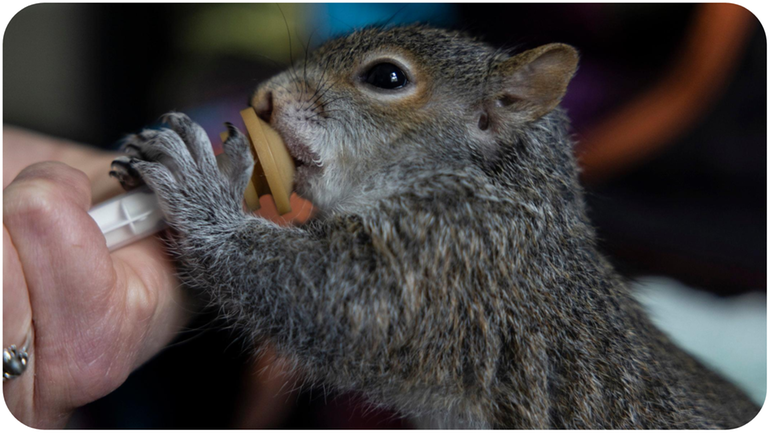
On a spring afternoon earlier this month, a call came in to the Evelyn Alexander Wildlife Rescue Center: A woman had found a nest of baby squirrels in the Jeep she’d been working on in Greenport.
Worried that touching the nest would cause the mother to abandon her litter, the caller was looking for help and texted a photo of the babies to the Hampton Bays center. Noelle Dunlop, a licensed wildlife rehabilitator and one of the center’s resident possum, bunny and squirrel experts, texted back, “It looks like they are 4-5 weeks old, because their eyes aren’t open yet.”
So what to do? Although eager to get back to work on the Jeep, the caller said, “I don’t want to evict her (the squirrel mother) into homelessness.”
Dunlop, who is in her 50s and lives in Miller Place, had the solution in a nutshell. With the calm confidence of a country doctor, she reassured the caller that the squirrels’ mama was still around and advised her to keep the family dogs in the house so they wouldn’t scare the mother away.
“What you want is for her to come back for her babies,” said Dunlop, who is also the center’s director of development.
The call was one of hundreds Long Island wildlife rehabilitators say they will likely receive during the spring baby season, which began in March and continues through the summer. Continuing loss of habitat, greater awareness of the wild animals coexisting with humans and the ubiquity of mobile phones are all contributing to a dramatic rise in calls about injured or orphaned wildlife, experts said.
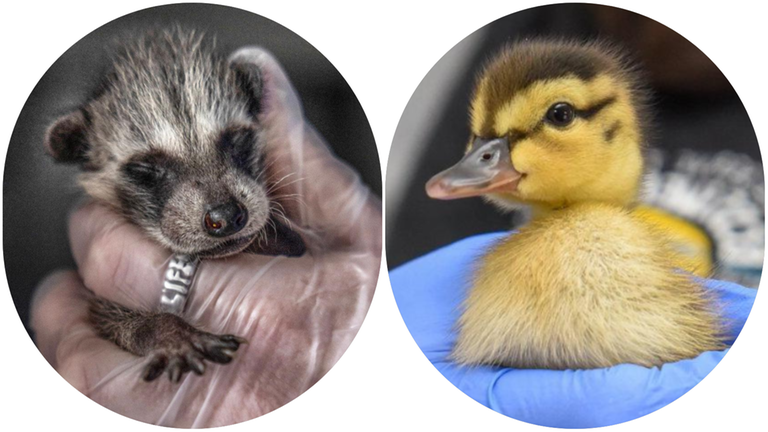
A baby raccoon, left, at the Evelyn Alexander Wildlife Rescue Center in Hamptons Bays April 12. Janine Bendicksen holds an abandoned mallard duckling, right, that was dropped off to the Sweet Briar Nature Center in Smithtown April 10. Credit: Alejandra Villa Loarca and Elizabeth Sagarin
“With the arrival of spring and summer, there are many newborn and just-hatched wildlife and an increase in wildlife activity,” said Kelly Hamilton, a wildlife biologist at the state Department of Environmental Conservation’s Region 1 Office in Stony Brook. During the spring months, she said, “It’s very common for the DEC to receive increased calls regarding sick/injured wildlife.”
The calls are already flooding into the Steven Goldman Wildlife Rehabilitation Clinic at Sweetbriar Nature Center in Smithtown and the Wildlife Center of Long Island in Huntington.
30 CALLS A DAY
“We are inundated,” said Janine Bendicksen, director of wildlife rehabilitation at Sweetbriar. With 30 calls a day, some coming in as early as 3 a.m., she said, “We call it the crazy season.”
Around 3,000 animals are treated annually at Sweetbriar, up from 600 when Bendicksen, 61, of St. James, joined the staff 23 years ago. She ascribes the uptick to what she called “continued destruction of animal habitats” and an increase in referrals from veterinarians who’ve become aware of the center’s free services. Technology is also at work, with cellphones making it easier to report injured or orphaned wildlife on the spot.
“People can take pictures and FaceTime us, and we can talk them through it [the rescue],” she said.
The Wildlife Center of Long Island, meanwhile, receives about 10,000 calls annually from its coverage area — the “densely populated” communities of Queens, Nassau and western Suffolk counties, said director of rehabilitation Lauren Schulz. Last May, about 1,100 calls were received, she said, with most involving “wildlife in distress and human-wildlife conflict.”
The spring baby season accounts for approximately 75% of the center’s 2,200 annual admissions, Schulz said.
Among the recent patients was a bald eagle from Kings Point. It was brought in after being injured in a territorial dispute with another eagle, Schulz said, and released into the wild following a 10-day stay for treatment of wounds to its feet and lead toxicity.
We are always happy when we can return an animal that has overcome so much back to its rightful home in nature.
Lauren Schulz, director of rehabilitation
Watching the eagle soar into the sky was “a deeply gratifying experience,” Schulz said. “We are always happy when we can return an animal that has overcome so much back to its rightful home in nature.”
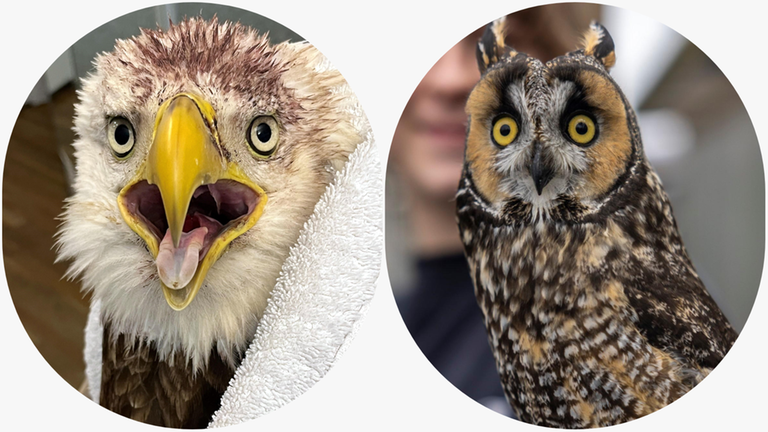
A bald eagle, left, at the Wildlife Center of Long Island in Huntington. Animal Care Assistant Emma Sanwald, holds Leona, right, who is the Evelyn Alexander Wildlife Rescue Center’s long-eared owl ambassador April 12. Credit: Eric Gettler and Alejandra Villa Loarca
On Long Island, the DEC trains and licenses wildlife rehabilitators to aid in the care and recuperation of injured or sick wild animals. These state-licensed rehabilitators “are the only people legally allowed to receive and treat distressed wildlife,” Hamilton, of the DEC, said. The wildlife rehabilitator’s goal is to release “a healthy animal back into the wild, where it belongs,” she said.
A lot of people don’t realize what they have in their own backyard.
Joe Rocco, wildlife rescue and rehabilitator
Joe Rocco, 38, of Riverhead, is one of dozens of Long Islanders licensed by the state to conduct wildlife rescue and rehabilitation. He said he takes to heart the DEC’s encouragement to educate the public about native wildlife.
“A lot of people don’t realize what they have in their own backyard,” said Rocco, who with his partner, Jackie Roche, 42, founded The Broken Antler Wildlife Search and Rescue in Riverhead.
Rocco, who formerly worked in construction, decided to give up that job when his mother was diagnosed with cancer in 2019. “I needed to be there for her,” he said. After his mother died later that year, Rocco said he obtained his New York State wildlife rehabilitation license while volunteering for the Evelyn Alexander center.
His organization, named after a deer he rescued, is also hopping this spring.
“I’ve re-nested 10 baby owls since the 22nd of March,” Rocco said, using the term for replacing baby birds in a nest.
The moms love their babies. They’re going to take care of them.
Joe Rocco, wildlife rescue and rehabilitator
Re-nesting is often preferable to taking a baby bird to a rescue center, he said. And contrary to popular belief, he said, “It doesn’t matter if you touch them [the baby birds]. The moms love their babies. They’re going to take care of them.”
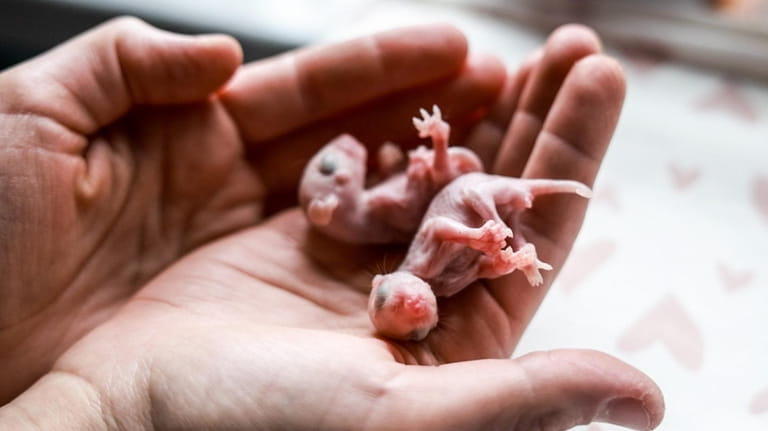
Baby opossums at the Evelyn Alexander Wildlife Rescue Center in Hamptons Bays, Thursday April 12, 2024. Credit: Newsday/Alejandra Villa Loarca
CALL FOR HELP RIGHT AWAY
But, said Rocco, when birds and other animals require medical attention, calls should be placed immediately to a wildlife center.
Sweetbriar Nature Center, a 54-acre educational and rehabilitation facility, features kid-friendly attractions like a butterfly vivarium, which opens in June, nature trails and a children’s play area. There are also wildlife exhibits in its main building. Behind the scenes, however, a small staff works with dozens of volunteers to rehabilitate animals.
In the mammal room, stressed-out bunny orphans were being cared for earlier this month. In the dedicated bird room, a month-old baby great horned owl was waiting to be re-nested after a 60-foot fall from a pine tree in Garden City. Bendicksen said that she initially took the owlet home at night to make sure its nocturnal feeding habits were met until it could eat on its own.
“We do everything a vet can do except set fractures,” she said. Veterinarians often volunteer to perform surgery, such as the recent neutering of a red fox.
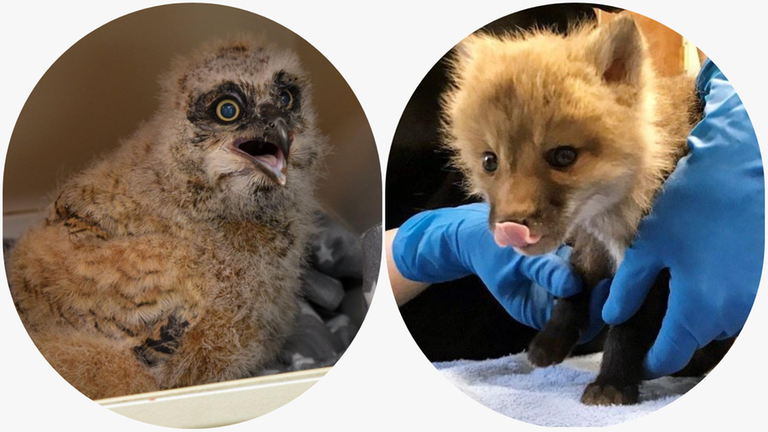
A baby Great Horned Owl, left, is being rehabilitated at Sweet Briar Center in Smithtown April 10. A Red Fox kit, left, is at the Wildlife Center of Long Island. Credit: Elizabeth Sagarin and Wildlife Center of Long Island
On a recent afternoon, Kiyolena Borch, 51, of East Setauket, sat patiently in the Sweetbriar reception area holding a Skechers shoe box. Inside, a small, silent, black, grey and white chickadee rested on a folded washcloth.
“The cat brought it in her mouth while we were hanging curtains,” said Borch, a French teacher at Northport High School. “She dropped it as soon as my husband yelled.”
Bendicksen picked up the bird in her cupped hand and gently examined it. Although tail feathers were pulled out in the attack, the bird was probably just in shock, she said. Antibiotics would be administered to prevent the bird from dying from Pasteurella, a bacteria cats can transmit from their mouths.
That same day in the center’s backyard, another patient gained his freedom. A wild turkey, which had just completed a month’s recovery after being attacked by a dog, seemed hesitant to leave at first.
“I’m going to kind of chase him out,” Bendicksen said. She entered the turkey’s enclosure, corralled it with her hands and encouraged it to go through the open door and into the sunlight. The turkey eventually got the message and disappeared in the underbrush.
To get them back into the wild feels so rewarding.
Russell Korn, staff member
“To get them back into the wild feels so rewarding,” said staff member Russell Korn, 20, of Commack, who assisted in the release.
A DIFFICULT DOWNSIDE
Not all rehabilitation efforts have such a happy ending, however.
Some animals that are not candidates for release can thrive in educational facilities. If, however, the animal’s injuries are too extensive and it will be in pain the rest of its life, there is a third option. “We would have to euthanize,” Dunlop said.
“Something people don’t realize when they bring us these delicate, broken creatures is it can be very rewarding when you can release them back into the wild, but heartbreaking when you can’t save them,” she said.
But remember those baby squirrels in the Jeep? Fortunately, their future is now “much more assured,” Dunlop said.
Just as Dunlop predicted, the mother squirrel returned. And rather than move them, the caller decided “to wait it out” until the babies matured and left the nest on their own, which Dunlop said could take up to three months.
“You made my day,” Dunlop texted her. “Thank you for your kindness to mama squirrel.”
HOW TO GET HELP FOR WILDLIFE IN DISTRESS
If you discover sick or injured wildlife, or believe a baby animal has been orphaned, immediately contact a rehabilitator for advice, local wildlife experts said. “Always reach out to see if the animal needs intervention,” said Noelle Dunlop of the Evelyn Alexander Wildlife Rescue Center in Hampton Bays. “We can guide the caller to make that decision.”
Some animals require special handling, while others may have diseases that can be transferred to people, according to the state Department of Environmental Conservation. The DEC recommends taking extra precautions around bats, raccoons and skunks, which have a higher risk of carrying rabies that can be transmitted to people and pets.
The DEC’s list of licensed wildlife rehabilitators in Nassau and Suffolk counties, along with their specialties and contact information, can be found at bit.ly/43WuOr0.
Long Islanders can also contact the following rehabilitators for assistance:
- Evelyn Alexander Wildlife Rescue Center, 228 W. Montauk Hwy. in Hampton Bays, wildliferescuecenter.org. The center is open from 8 a.m. to 5 p.m. daily. Call 631-728-4200 or its hotline, 631-728-WILD (9453).
- The Steven Goldman Wildlife Rehabilitation Clinic at Sweetbriar Nature Center, 62 Eckernkamp Dr. in Smithtown, sweetbriarnc.org/wildlife-rehabilitation. Calls are answered from 9:30 a.m. to 4:30 p.m. at 631-979-6344.
- Wildlife Center of Long Island, Huntington, wildlifecenterli.org. Call the Wildlife Hotline at 516-674-0982.
— Jim Merritt
